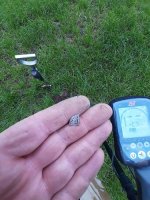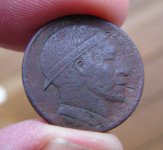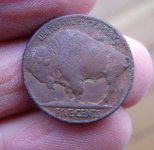LovestheShiny!
Forum Supporter
Since there seems to be some ongoing discussion about the benefits / limitations of the AT Pro vs the Equinox machines, I thought I'd give some observations...
First some ground rules and background. I own and use a Garrett AT Pro detector that I purchased back in late March of 2017. I have found a ton of coins with this machine (over 500 Silver Coins, over 2,500 wheat pennies, many Sterling Rings, a few gold rings, and lots of really cool stuff including a Hobo Nickel, Wild West trick shooting coin, 4 Silver Peace Dollars, tokens, IHP's and much more) in the last 2 1/2 years. I think I know the AT Pro pretty well and feel I can really understand what it is telling me regarding targets. This comparison is based on actual "in the field" detecting, not a test bed or air tests. When detecting with my friends who use the Nox models, we often compare signals and see how well each type of detector performs on certain targets. Almost all of my detecting friends here in Montana, or out of town friends, use either the Equinox 600 or Equinox 800. I have been quite impressed with the Equinox detectors, and have seen how well they work. In a general sense, they (being multi-freq VLF) are superior to my single freq VLF detector.
My AT Pro settings... Pro Zero, Iron Audio Off, nothing notched out, Max sensitivity, and nothing descriminated out.
The Nox settings that my friends use are generally Park 1 or Park 2, with some minor custom adjustments.
Soil and Climate conditions... moderate mineralization, semi arid climate, coins are not super deep, most within 6-7 inches of the surface. This comparison is for dirt hunting only here in Montana. (I did try my AT Pro at a Seattle WA salt water beach, it did OK in the dry sand but was useless in the shallow salt water and wet sand. The Nox Multi Freq would be far superior to the Pro in this situation).
Nickels - the Nox is rock solid in finding nickels, and gives a very reliable and steady "13" or "12-13" no matter the depth of the coin. The AT Pro will detect that same nickel, but has not as steady a digital readout depending on the depth of the nickel. A surface nickel for the Pro is pretty much a solid "52-53" but on the older deeper Buffalo Nickels and "V" Nickels, the VDI can vary from "48-52." When getting that varying signal, I have had my Nox buddies check out my signal and when they say "nickel" I dig and it has always been a deep nickel.
Pinpointing - I have noticed my Nox friends sometimes have a difficult time pinpointing their targets, especially a shallow target. They have called me over after opening a plug when they have a problem finding the coin with their pinpointer, and I can always nail it down with the AT Pro. I feel the AT Pro pinpoints better than the Nox. I use the "wiggle method" about half the time, and the pinpointer button about half the time.
Depth - the Nox detects deeper than the AT Pro. An example... one time my friend with the Nox 600 and I were detecting up in Great Falls at a 1920's home with newer lawn and extra dirt... he would get a target in the high teens / low 20's on the VDI, and let me know he thought it was a deep wheat penny 9" down. I would swing the AT Pro coil over the target, and just get some undecipherable grunt or nothing at all.
Tones and general VDI readout - I think the AT Pro is somewhat superior in this respect, even with just 3 tones, as I have no doubt as to what I am swinging the coil over. I have done this comparison with my friends many times, and the digital readout is good... I can call wheatie (78-79), copper memorial (80-82), clad dime (81), clad quarter (86-87), or possibly something even nicer like silver, pretty much all the time. Perhaps this has to do with my knowing my machine and digging many thousands of targets with it. One of my friends with the Nox 800 is also quite good at letting me know when he thinks he has a nice "shiny coin" waiting in the ground.
Highly Mineralized soil - the Nox is superior. On one trip, my friend with the Nox 800 and I detected for a day in Butte Montana. I guess there is a reason they called the mines there "The Richest Hill on Earth" as tons of copper, silver and some gold came out of the ground. The soil is highly mineralized, my AT Pro ground balanced at "94" (with a max of "99" possible). The Equinox clearly outperformed my AT Pro in this soil, I did get the same number of silvers as my friend, but my machine seemed extra chatty and did not seem to have much depth. The Equinox was much less affected by the high mineralization.
Trashy ground - the Nox does better here, though the AT Pro is no slouch. When I get close to a home while detecting the front yard, my AT Pro really picks up the roofing nails and small bits of construction debris, and becomes pretty chatty. By slowing down my swing speed a bit, and really listening for even short high tones, I can home in on good targets. The Nox seems to have less an issue with trashy soil.
Build quality - I think the AT Pro wins here, though not by a ton. I've had no issues at all in the years that I've owned my same machine. Some of my buddies have replaced the arm cuff, one a shaft, one a bad coil, and most have gotten rid of the factory earphones and replaced them with something of higher quality.
Ease of operation - Both machines are pretty equal here - as for setting up to detect, my AT Pro is a "power up and detect" machine, while I've seen my friends occassionally spend some time getting their machines ready to detect. Of course, they are adjusting the parameters for optimized detecting.
Summary - FOR WHERE I DETECT (very important) - moderate mineralization, semi arid climate, not super deep coins, not super trashy - the AT Pro does as well as the Nox models.
When detecting with my Nox buddies, our Silver totals, wheat penny totals, clad coins and copper pennies at the end of the hunt are pretty equal. If I lived in an area where the organic build up of soil was significant, with lots of rain, soft soil, and resultant much deeper coins, or consistently highly mineralized soil, the Equinox would definitely be the better choice. Hope this comparison is of help, I am impressed with the Equinox performance, but again, very satisfied with my AT Pro for where I detect and the type of detecting I do. Thanks for your interest!
First some ground rules and background. I own and use a Garrett AT Pro detector that I purchased back in late March of 2017. I have found a ton of coins with this machine (over 500 Silver Coins, over 2,500 wheat pennies, many Sterling Rings, a few gold rings, and lots of really cool stuff including a Hobo Nickel, Wild West trick shooting coin, 4 Silver Peace Dollars, tokens, IHP's and much more) in the last 2 1/2 years. I think I know the AT Pro pretty well and feel I can really understand what it is telling me regarding targets. This comparison is based on actual "in the field" detecting, not a test bed or air tests. When detecting with my friends who use the Nox models, we often compare signals and see how well each type of detector performs on certain targets. Almost all of my detecting friends here in Montana, or out of town friends, use either the Equinox 600 or Equinox 800. I have been quite impressed with the Equinox detectors, and have seen how well they work. In a general sense, they (being multi-freq VLF) are superior to my single freq VLF detector.
My AT Pro settings... Pro Zero, Iron Audio Off, nothing notched out, Max sensitivity, and nothing descriminated out.
The Nox settings that my friends use are generally Park 1 or Park 2, with some minor custom adjustments.
Soil and Climate conditions... moderate mineralization, semi arid climate, coins are not super deep, most within 6-7 inches of the surface. This comparison is for dirt hunting only here in Montana. (I did try my AT Pro at a Seattle WA salt water beach, it did OK in the dry sand but was useless in the shallow salt water and wet sand. The Nox Multi Freq would be far superior to the Pro in this situation).
Nickels - the Nox is rock solid in finding nickels, and gives a very reliable and steady "13" or "12-13" no matter the depth of the coin. The AT Pro will detect that same nickel, but has not as steady a digital readout depending on the depth of the nickel. A surface nickel for the Pro is pretty much a solid "52-53" but on the older deeper Buffalo Nickels and "V" Nickels, the VDI can vary from "48-52." When getting that varying signal, I have had my Nox buddies check out my signal and when they say "nickel" I dig and it has always been a deep nickel.
Pinpointing - I have noticed my Nox friends sometimes have a difficult time pinpointing their targets, especially a shallow target. They have called me over after opening a plug when they have a problem finding the coin with their pinpointer, and I can always nail it down with the AT Pro. I feel the AT Pro pinpoints better than the Nox. I use the "wiggle method" about half the time, and the pinpointer button about half the time.
Depth - the Nox detects deeper than the AT Pro. An example... one time my friend with the Nox 600 and I were detecting up in Great Falls at a 1920's home with newer lawn and extra dirt... he would get a target in the high teens / low 20's on the VDI, and let me know he thought it was a deep wheat penny 9" down. I would swing the AT Pro coil over the target, and just get some undecipherable grunt or nothing at all.
Tones and general VDI readout - I think the AT Pro is somewhat superior in this respect, even with just 3 tones, as I have no doubt as to what I am swinging the coil over. I have done this comparison with my friends many times, and the digital readout is good... I can call wheatie (78-79), copper memorial (80-82), clad dime (81), clad quarter (86-87), or possibly something even nicer like silver, pretty much all the time. Perhaps this has to do with my knowing my machine and digging many thousands of targets with it. One of my friends with the Nox 800 is also quite good at letting me know when he thinks he has a nice "shiny coin" waiting in the ground.
Highly Mineralized soil - the Nox is superior. On one trip, my friend with the Nox 800 and I detected for a day in Butte Montana. I guess there is a reason they called the mines there "The Richest Hill on Earth" as tons of copper, silver and some gold came out of the ground. The soil is highly mineralized, my AT Pro ground balanced at "94" (with a max of "99" possible). The Equinox clearly outperformed my AT Pro in this soil, I did get the same number of silvers as my friend, but my machine seemed extra chatty and did not seem to have much depth. The Equinox was much less affected by the high mineralization.
Trashy ground - the Nox does better here, though the AT Pro is no slouch. When I get close to a home while detecting the front yard, my AT Pro really picks up the roofing nails and small bits of construction debris, and becomes pretty chatty. By slowing down my swing speed a bit, and really listening for even short high tones, I can home in on good targets. The Nox seems to have less an issue with trashy soil.
Build quality - I think the AT Pro wins here, though not by a ton. I've had no issues at all in the years that I've owned my same machine. Some of my buddies have replaced the arm cuff, one a shaft, one a bad coil, and most have gotten rid of the factory earphones and replaced them with something of higher quality.
Ease of operation - Both machines are pretty equal here - as for setting up to detect, my AT Pro is a "power up and detect" machine, while I've seen my friends occassionally spend some time getting their machines ready to detect. Of course, they are adjusting the parameters for optimized detecting.
Summary - FOR WHERE I DETECT (very important) - moderate mineralization, semi arid climate, not super deep coins, not super trashy - the AT Pro does as well as the Nox models.
When detecting with my Nox buddies, our Silver totals, wheat penny totals, clad coins and copper pennies at the end of the hunt are pretty equal. If I lived in an area where the organic build up of soil was significant, with lots of rain, soft soil, and resultant much deeper coins, or consistently highly mineralized soil, the Equinox would definitely be the better choice. Hope this comparison is of help, I am impressed with the Equinox performance, but again, very satisfied with my AT Pro for where I detect and the type of detecting I do. Thanks for your interest!
Last edited:









